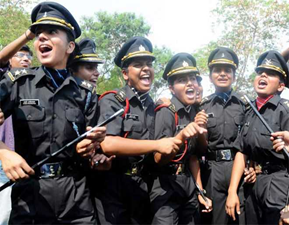

Context
For the first time, the Indian army had begun the process for selection of women officers for command postings in the rank of Colonel, which has so far been the domain of male officers.
About
- 80 women officers in the Indian Army have been cleared for the rank of Colonel (selection grade), making them eligible to command unitsin their respective arms and services for the first time.
- The Women Officers were selected by the Special No. 3 Selection Boardfor promotion from the rank of Lt Colonel to Colonel to bring them on a par with their male counterparts.
- Women officers were selected from the batch of 1992 to 2006in various arms and services, including Engineers, Signals, Army Air Defence, Intelligence Corps, Army Service Corps, Army Ordnance Corps and Electrical and Mechanical Engineers.
- The Corps of Engineers has the maximum vacancyfollowed by the Army Ordnance Corps and Electrical and Mechanical Engineering.

Women Induction in Army: A battle long fought
- 1992: Women were first inducted into the Indian Army as officers in non-medical roles while the Indian Army Medical Corps started inducting them from 1993.
- 2010: Delhi High Court ruled that the Indian Army's policy of not allowing womento serve in combat roles was discriminatory and violative of the Constitution.
- 2013:Supreme Court upheld the decision of the Indian Army to exclude women from certain combat roles, stating that the Indian Army was not ready for women in combat roles due to societal attitudes and lack of infrastructure.
- 2016: Indian Army announced that it would begin inducting women into combat roles in select military units, starting with the Corps of Military Police.
- 2017: Supreme Courtstated that women should be given equal opportunities in the Army, including in combat roles.
- 2020:Indian Army announced that it would open up all positions to women, including those in combat roles
- 2021: The Indian army starts to induct women in short service commission as fighter pilots.
Violation of Rights:
- Right to equality (Article 14): The exclusion of women from certain roles in the Indian Army has been seen as a violation of this right, as it discriminates against women on the basis of their gender.
- Right to work (Article 15): The exclusion of women denies them the opportunity to work in certain roles based solely on their gender.
- Right to non-discrimination (Article 16): The exclusion of women from certain roles in the Indian Army is a violation of the right to non-discrimination, as it discriminates against women on the basis of their gender.
- Right to life and personal liberty (Article 21): The exclusion of women is a violation of the right to life and personal liberty, as it denies women the opportunity to serve their country and defend their rights and liberties.
- Right to education (Article 21): Exclusion from certain roles in the Indian Army is a violation of the right to education, as it denies women the opportunity to pursue education and training in certain fields.
- Right to freedom of expression (Article 19): The exclusion of women denies women the opportunity to express themselves and their capabilities through their work.
|
Advantages of women in Army |
Challenges of women in Army |
|
|
Way Ahead:
- Although allowing women on equal footing in the army is a progressive step, the Indian Army should take steps to create a more supportive environmentfor women, such as increasing the number of women-only barracks and providing childcare facilities.
- While there have been challenges with the induction of women into the Indian Army, there is a need to promote the overall trend as many women have succeeded in their roles and made valuable contributions to the military.



